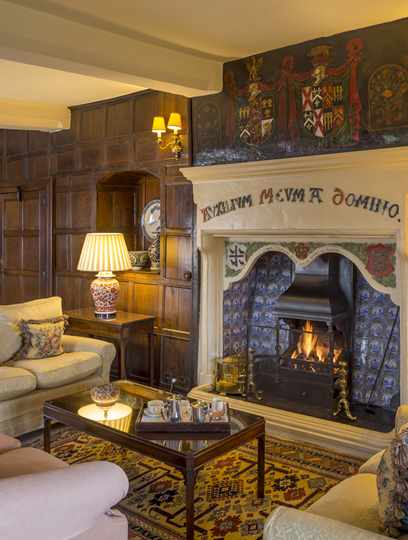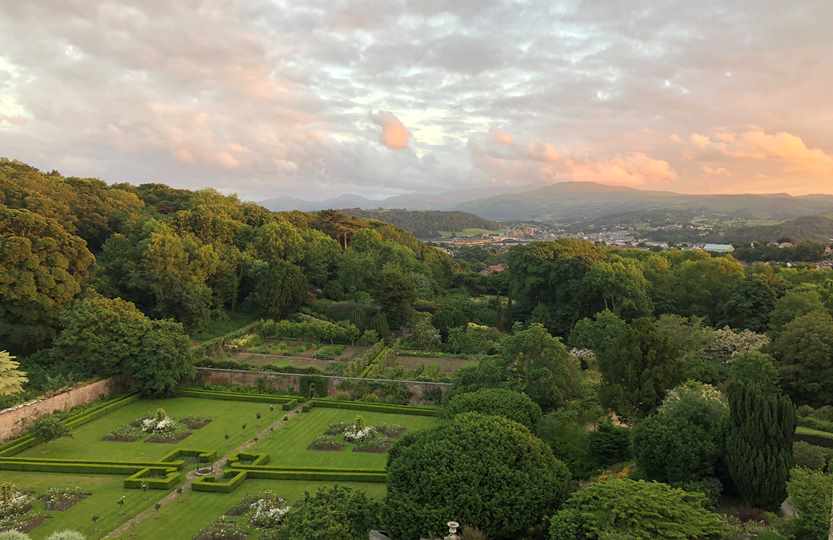HISTORY
A noble history? The name ‘Bodysgallen’ may mean either 'house among thistles' or 'the abode of Cadwallon', a 6th century chieftain.
Bodysgallen Hall, Grade 1 17th Century House
Bodysgallen Hall is a Grade 1 17th century house that has been skilfully and sympathetically restored by Historic House Hotels Limited since 1980 and given to the National Trust in 2008.
Bodysgallen is situated on the west side of Pydew mountain, almost invisible except for its chimneys, which overtop the trees. In 1810, the historian Fenton noted that it is 'embosomed in woods of noble growth, which are suffered to luxuriate their own way without any fear of the axe'.
Despite the gradual addition of one wing, then another, during a building history of 600 years, the whole house is built in the same sturdy and conservative style. The name may mean either 'house among the thistles' or 'the abode of Cadwallon', a sixth century chieftain. The oldest part of the house is the five-storey tower, probably dating from the late sixteenth century, and possibly built as a watch tower for Conwy Castle.
The long connection between the house and the Mostyn family started in the sixteenth century, late in the Elizabethan era, when it was owned by Richard Mostyn, who served as High Sheriff of Caernarfonshire, that it became a residential house. In the early seventeenth century Margaret Mostyn married Hugh Wynn; it is their son, Robert Wynn whose initials, with those of his wife Katherine, appear on the datestone with the year 1620 on the south gable "1620 R:W:K".
The two main storeys of this early seventeenth century block comprise a large entrance hall, and an equally large room above, now the Drawing Room. Both rooms have two fireplaces, one in a bay in the corner. In the Drawing Room on the first floor, there are the 17th century coats of arms of the Mostyns, Wynns and Vaughans. The kitchen wing was added in 1730. During this period the gardens were being established, with the gradual development of the pattern of walled gardens which are to be seen today. In 1823, the Mostyns pioneered the installation of a water closet from one John W. Williams of St. Asaph.
By the end of the nineteenth century, Bodysgallen had become something of an architectural jumble, with brick chimneys and Georgian sliding sash windows. It was rescued from this state by the formidable Lady Augusta Mostyn, who restored and enlarged it around the turn of the century for her second son, Colonel Henry. The sensitivity of her work is remarkable in restoring the vernacular architecture of the house, which plays such an important part in creating its atmosphere today.
During the first world war, Colonel Henry Mostyn raised the 17th Battalion of the Royal Welsh Fusiliers, whom he paraded in the park to the north of the house. The oak tree in the centre of the field commemorates this.
Following the death of Colonel Henry in 1938, and his widow in 1949, their eccentric son, Ievan Mostyn, succeeded and the house entered a long period of gradual decline. His niece sold the property in 1969 when it became a private guest house. After purchase, Historic House Hotels commenced their restoration in 1980, and the house opened as a hotel, in its present form, between 1981 and 1983. In September 2008 Historic House Hotels Ltd and its interest in all its properties were given to the National Trust to ensure their long-term protection.
*Today you enter the oldest part of the house, the main hall, above which is the Drawing Room featuring a magnificent fireplace. Here you will find the 17th century coats of arms of the Mostyns, Wynns and Vaughans, which are also found in the stained glass windows in the Dining Room and main stairwell.
Bodysgallen Hall has gradually evolved over the centuries from modest hamlet to a large and comfortable country house, with restored and converted outbuildings, surrounded by one of the finest Arts and Crafts gardens in Wales.
A short history of Bodysgallen Hall has been written by Oliver Garnet detailing family connections and exploring Bodysgallen that can be purchased from the hotel reception.*

